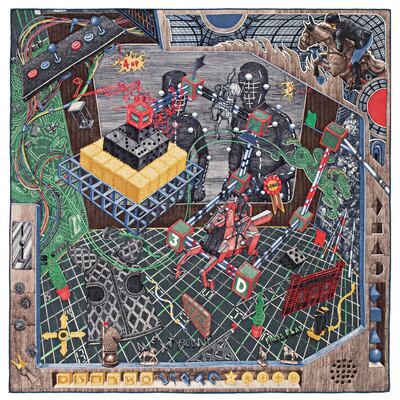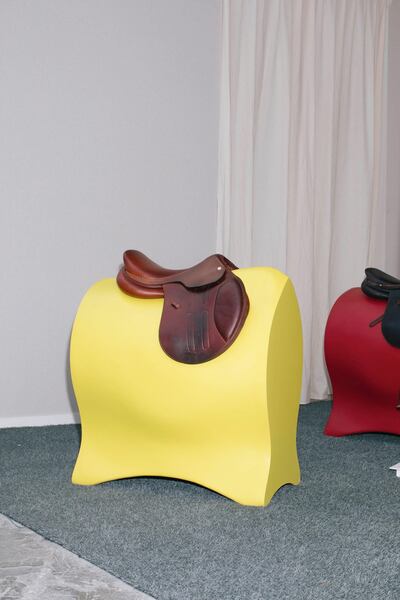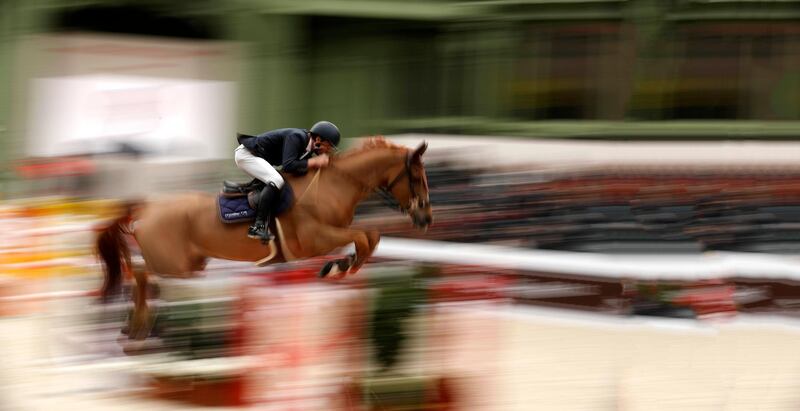To truly understand the house of Hermès – to appreciate its quirks and curiosities, and the way that the past is constantly informing the present – one must travel deep into the building at 24, Faubourg Saint-Honoré that is home to the brand's Paris flagship; through the hidden corridors and narrow staircases that were so charmingly referenced in Nigel Peake's Promenade au Faubourg scarf; and enter the secret space that houses the private collection of Emile Hermès.
Here, you will find zoetropes and praxinoscopes, ancient Japanese saddles, 18th-century bridles and spurs from Chile. There's a copy of Della Cavalleria (1609), a guide to all things horse-related; stools crafted from stingray; and studded collars that undoubtedly acted as the inspiration for the Collier de Chien bracelets. There's a tricycle that once belonged to the son of Napoleon III; and one of the first bags that Hermès ever created with a zip.
A deep-seated curiosity about the world; an inherent sense of whimsy; a respect for the horse and all that it has done to further civilisation; and the understanding that objects can become more than objects when they are cherished by someone. These are the guiding principles of Emile’s collection – and the Hermès brand.
Emile is the man credited with bringing Hermès into the present. During the First World War, he travelled to North America, where the motorcar was already taking over the streets. Until then, Hermès – founded in 1837 by Emile’s grandfather, Thierry – had been solely preoccupied with crafting harnesses, bridles and saddles for horses, then the primary method of transportation. As the company’s employees still like to point out, for more than half its existence, Hermès’s only customer was the horse.
Nonetheless, on his return to Paris, Emile was smart enough to realise that a company with no other customer might soon find itself out of business. His brother and business partner maintained that if there were no horses, there would be no Hermès, and promptly extricated himself from the company. Emile, meanwhile, expanded into fine-leather goods and luggage, laying the foundations for a brand that now applies its expertise to bags, homeware, clothing, shoes, jewellery, watches and fragrances.

That’s not to say the horse has been forgotten – to this day, the animal enjoys exalted status within the maison. There’s the logo, of course, which features two horses and a carriage flanked by a groom; there are the horse motifs that appear, in countless guises, on Hermès’s scarves; the closure of the Verrou bag, which mimics the bolts commonly found on stable doors; and the Samarcande paperweights, shaped like sculptural horse heads and reinterpreted in different materials every season. But the brand’s horsey heritage also manifests itself in more subtle ways, explains Marion Larochette, equestrian métier director at Hermès.
“There are some hidden influences. For example, in the leather goods, all the metallic parts are functional, not just for decoration. I think that the style of Hermès, the elegance that it brings to its products, is also directly influenced by its equestrian heritage.
“In the very beginning, Hermès harnesses received some very famous prizes and were very different from what existed at the time – harnesses then were very decorative. The Hermès idea was that there is nothing more beautiful than a horse. So instead of hiding the horse with decorations, you have to reveal it. Hermès harnesses were very pure in their design and as light as possible, and I think that this kind of sober elegance remains in all of the brand’s activities,” Larochette explains.
“We always say that Hermès pays a lot of attention to details; for example, in a jacket, we might put a leather lining in a pocket, just for the wearer. I think that also comes from our equestrian heritage. Hermès saddlers used to say that when your client is a horse, you really need to pay attention to details,” she adds. “Because if your client is a man and there is something wrong, he will come back and complain. But the horse can’t complain.”
• • • • •
A few floors down from Emile’s former office, master saddlers continue to craft accessories for horses, much like they would have done in Hermès’s earliest days. On a shelf in a corner of the room, a row of ledgers dating back to 1909 contains a handwritten record of every order ever placed, with every saddle lovingly sketched out in ink, amidst carefully penned details about each customer. This lesser-known arm of the Hermès brand is still an important one – 500 saddles are handcrafted on these benches every year.
A folder contains pictures of some of the more unusual custom-made creations that have been made here over the years. There are saddles crafted from crocodile and ostrich leather, and others decorated in leopard print, cashmere and embroidery. There is one that bears the initials RR, for former United States president Ronald Reagan; one with wings, reminiscent of the mythical stallion Pegasus; and one created specifically for Bartabas, the famed French horse trainer and equine impresario.
“What makes our saddles special is two things,” says Larochette. “The first is the quality of our leathers. The second is the craftsmanship. We are the only ones still making saddles this way. Each saddle is made from A to Z by one craftsman, which is unique – it means they need to be excellent in saddlery know-how. We are also the last to use certain techniques.”

It takes about 30 hours for a more classical saddle to be produced and each order is made entirely from scratch. Hermès offers a number of saddle models, including the Arpège, Cavale and Allegro, but each piece is built to order from scratch, so that it fits the horse and rider exactly. “When you want to buy an Hermès saddle, we send an expert to the barns, to do a saddle-fitting. All of our saddle-making experts have a special tool that looks like a spider. You put it on the horse’s back. We use this tool to send to the workshop 100 points of measurement of the horse’s back.”
• • • • •
Huddled against the icy cold under the exquisite domed-glass ceiling of Paris’s famed Grand Palais, the crowd lets out a collective groan as Patrice Delaveau and his horse Aquila HDC bring an obstacle crashing down. The stakes are almost as high as the mammoth 1.6-metre jumps. Delaveau is one of the last competitors in the jump-off for the Grand Prix Hermès, the final and most prestigious class of the three-day Saut Hermès showjumping event. A total of 13 riders have raced against the clock to complete the course – and the chances of more than one have been dashed by that same obstacle. The stands are full, even though an unexpected icy snap has rendered the spectacular nave of the Grand Palais semi-Arctic in temperature. The tension is palpable.
It is Delaveau’s fellow Frenchman Simon Delestre who eventually emerges victorious, racing around the course in an awe-inspiring 34.54 seconds. The victory is particularly sweet, I imagine. There is the €400,000 (Dh1.8 million) prize, of course – but Delestre is also one of Hermès’s partner riders, a select group of 20 equestrian athletes whom the brand collaborates with. His horse bears the Hermès name, while his saddle and bridle have been handcrafted by the artisans at 24, Faubourg Saint-Honoré.
“Hermès Ryan performed brilliantly; I don’t have the words to explain how amazing this horse is,” Delestre, who is currently number 9 in the world rankings, enthuses after his win. “This competition is really special for me. I knew that the jump-off would be quick, but Ryan is a fast horse. He’s my favourite horse. He always gives 110 per cent.”

Saut Hermès came into being nine years ago as a way of reiterating the brand’s long-standing connection to the equestrian world. And while it may have initially lacked legitimacy from a sporting point of view, it wasn’t difficult to get top-class riders to participate, says Anne-Sarah Panhard, managing director of Hermès Distribution France. The 2018 edition of the event attracted such legends as Kevin Staut, Harrie Smolders, Marcus Ehning, Roger-Yves Bost, Bertram Allen and Edwina Tops-Alexander.
“I think the relationship with the horse is so authentic and so real at Hermès, that we managed very quickly to convince the best riders to come here. Something else that really helped is the magic of this place. If you’ve been to many horse competitions, you will know that it is quite rare for a competition to be in such an environment. Technically it is a competition that is very singular because it has the light of an outdoor competition, while it is held indoors. It has both complexities,” explains Panhard.
Sitting proudly on the Champs-Élysées, the Grand Palais was built for the Universal Exhibition of 1900, and serves predominantly as an exhibition hall and museum complex. But in its early days, it played host to countless equestrian events, says Larochette. “For almost one century, and half of its existence, Hermès had the horse as its only client. And Hermès was surrounded by horses everywhere on the streets of Paris. Then cars replaced horses. The Grand Palais is a perfect illustration of that because it was built for the Universal Exhibition, but also, in the beginning, to hold horse competitions. From 1900 to 1952, there were horse shows held very frequently in the Grand Palais, and there were stables in the basement.
“Eventually, in the Grand Palais, like the streets of Paris, the car replaced the horse. And instead of horse shows, there were car exhibitions. The idea behind the Saut Hermès was to give back the streets of Paris, or at least the Grand Palais, to the horse. It’s a tribute to the horse.”
This is quite literally the case as, for the duration of the event, the horses are housed in temporary stables that sit directly on the Champs-Élysées. Of course, the Saut is also another way for the brand to communicate that ever-present interplay between past and present (for those who might never get the chance to see Emile’s treasures). “We were at the Grand Palais before 1957, when there were equestrian competitions here, we were a part of that,” says Panhard. “So in a way, this is a return. It’s part of our history.”
________________
Read more:
[ Hermès takes pride in its legacy, there is never room to be smug ]
[ Montblanc pen pays tribute to The Little Prince ]
[ Inside look at East of Eden, the last of the Gilded Age mansions of Maine, now on the market ]
________________







